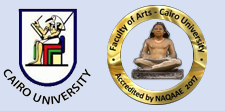عنوان المقال عربي
الوحدة اللغوية الممتدة فى تحليل المعني دراسة تحليلية قائمة على المدونات اللغوية بمعنى أيديولوجية
Document Type
Book Review
Keywords English
Model of Extended Lexical Unit, corpus linguistics investigation, Ideology, textual meaning, semantic preference, pragmatic prosody
Abstract English
The main porous of this paper is twofold: 1) displaying how Sinclair’s model Of Extended Lexical Unit (ELU) could be operationalized to discover textual functions in Arabic Language, and 2) applying the (ELU) model to explore the collocational meaning and linguistic profile of IDEOLOGY, one of the most frequent and ambiguous concept in Arabic media discourse. Methodologically, the analysis is based on a written contemporary corpus of Arabic (WMCA), consisting of 100 million words, indexed in CQP, and using the statistical measure T-score to identify the significant collocations of Ideology. The findings suggest the thorough application of the extended lexical unit in deducing the linguistic behavior of words, concepts, and phrases lexically, syntactically, semantically, and pragmatically. Equally important, the outcomes of such analysis emphasize the neo-Firthian principle, that is the textual meaning is not coded in individual words, rather in phrasal units that extend across the surrounding co-textual environment. Thus, as the case study clarifies, Ideology has a more comprehensive collocational frame that contributes in forming its textual and attitudinal meaning(s) and conceptual characteristics than the dictionary definition suggests. Although this approach has been increasingly adopted in applied linguistics, particularly in lexicography, Arabic studies still far away in this concern. As a theoretical contribution, the present study suggests extending Sinclair’s model to include a macro level of analysis that deals with discourse, so that the model works on two-direct phases of analysis: micro textual and macro discursive analysis.
الملخص العربي
في هذا البحث، أوضِّح كيف يعمل منهج "الوحدة اللغوية الممتدَّة" كما قدمه اللغوي الإنجليزي جون مكيرثي سنكلير John Sinclair لتحليل المعنى التصاحبي على المستوى المعجمي، والتركيبي، والدلالي، والتداولي، وكيف يفيد هذا المنهج في استقصاء السلوك اللغوي للوحدات اللغوية في الاستعمال الحي للغة المعاصرة. أما على المستوى التطبيقي، فيقدِّم البحث تحليلا لواحد من المفاهيم الثقافية الاجتماعية المُلبسة، وهو مفهوم "أيديولوجيَّة"، وهو مفهوم يتميز بالإطار التصاحبي الواسع، ويتداخل مع أنساق ثقافية مختلفة كاللغة والأدب والفلسفة والسياسة والاجتماع والدين، ويُستعمل في خطابات متنوعة كالخطاب الإعلامي والسياسي والديني؛ مما أكسبه معاني لغوية واجتماعية تَقصُر التعريفات المعجمية عن استيفائها ـ وهذا ما يستكشفه التحليل الاستقصائي في هذا البحث. ويقوم التحليل على مدونة إعلامية تتكون من 100 مليون كلمة تغطي 10 سنوات (من 2000 إلى 2009)، مُدرَجة في محلل المدونات الكبرى CQP، وباستخدام المقياس الإحصائي T-score لاستخراج المتصاحبات اللغوية الأكثر تكرارًا في المدونة المحلَّلة، وباستخدام المحلل التركيبي POS Tagger لتحديد الأنماط التركيبية التي يشيع فيها استخدام كلمة "أيديولوجية". وفي حين يتبنى كثير من اللغويين والباحثين هذا المنهج في الدراسات اللغوية الأجنبية (في تحليل الكيفية التي تعمل بها اللغة، ولاستكشاف الوحدات العبارية التي تكمن فيها المعاني التصاحبية والوظائف الخطابية)؛ فإنه في الدراسات اللغوية العربية لم يلقَ حظه بعد، لا تنظيرًا ولا تطبيقًا. ومن هنا تأتي أهمية هذا البحث، في تقديم الإطار النظري لمنهج "الوحدة اللغوية الممتدة"، وكيفية تطبيقه على المستويات اللغوية المختلفة بالاعتماد على منهجية المدونات اللغوية.
Recommended Citation
Saleh, Safwat Ali
(2019)
"The Model of Extended Lexical Unit: a corpus-based investigation of IDEOLOGY meaning,"
Journal of the Faculty of Arts (JFA): Vol. 79:
Iss.
1, Article 11.
DOI: 10.21608/jarts.2019.81538
Available at:
https://jfa.cu.edu.eg/journal/vol79/iss1/11
Digital Object Identifier (DOI)
10.21608/jarts.2019.81538
Accept Date
2018-04-11
Publication Date
1-1-2019

